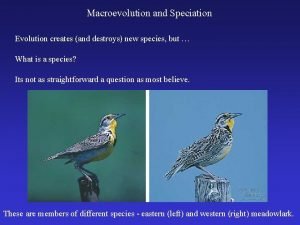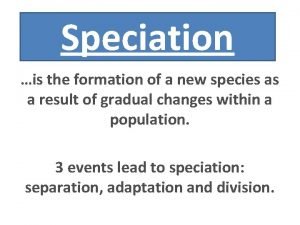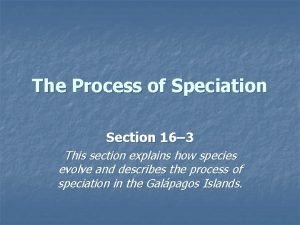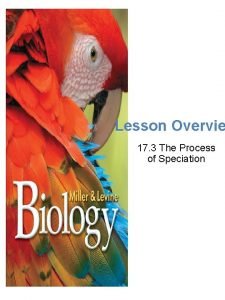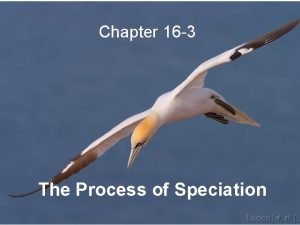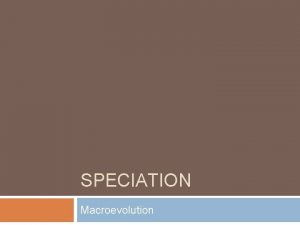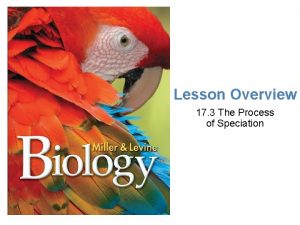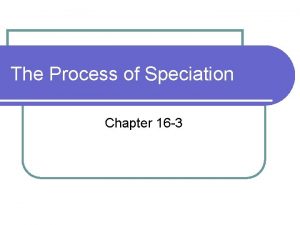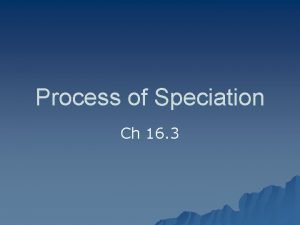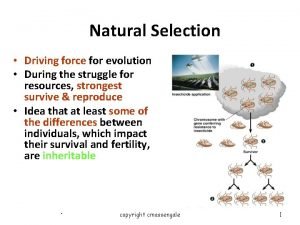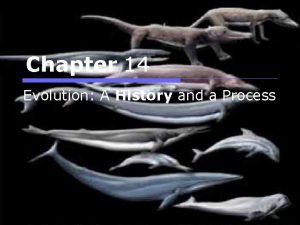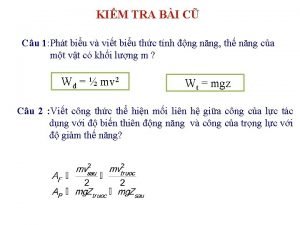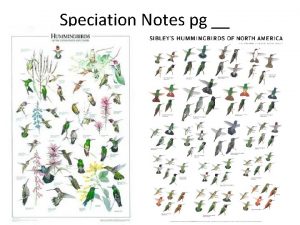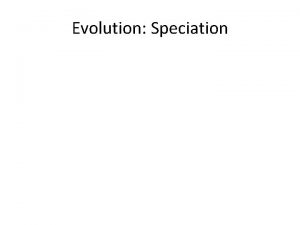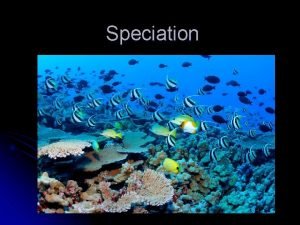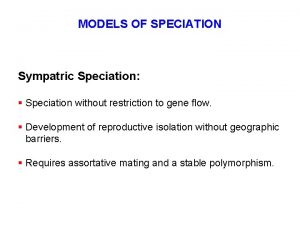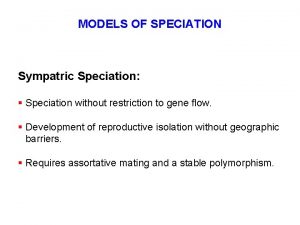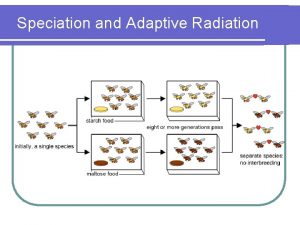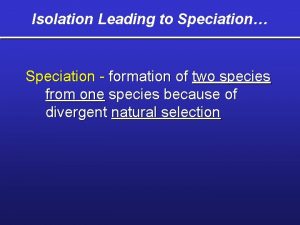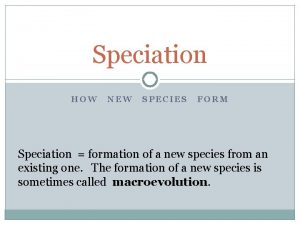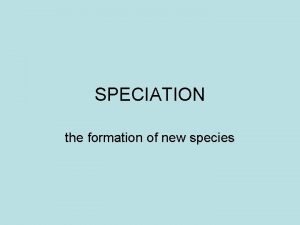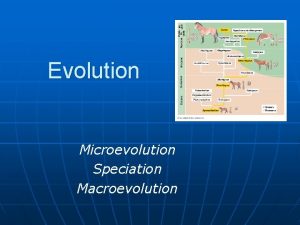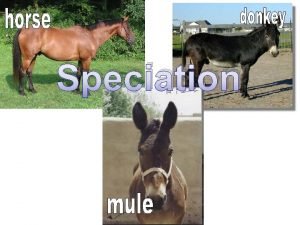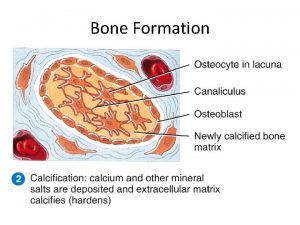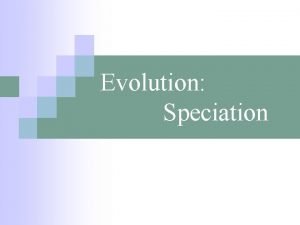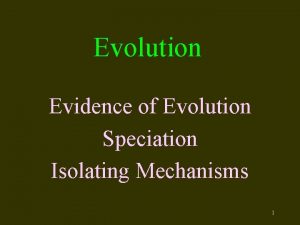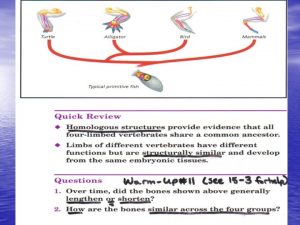Evolution Speciation C The Process of Speciation formation
































- Slides: 32

Evolution: Speciation

C. The Process of Speciation (formation of a new species) 1. Isolating mechanisms a. Reproductive isolation can develop in variety of ways- behavioral isolation, geographic isolation, temporal isolation The Eastern and Western Meadowlark have overlapping ranges but do not interbreed, because they have different mating songs

b. Behavioral isolation don’t interbreed because of differences in courtship rituals or other types of behavior https: //www. youtube. com/watch? v=Uar. Qh. AOr. Isg&ap p=desktop https: //www. youtube. com/watch? feature=player_det ailpage&v=o 42 C 6 ajjq. Wg

c. Geographic isolation two populations separated by geographic barriers (rivers, mountains, bodies of water)

d. Temporal isolation when two species reproduce at different times

Speciation Video https: //www. youtube. com/watch? feature=player_detailpag e&v=8 yv. EDqrc 3 XE


4. Genetic Drift may occur when a small group of individuals colonizes a new habitat. Individuals may carry alleles in different relative frequencies than the original larger population.

Genetic drift has been observed in some small human populations that have become isolated due to reasons such as religious practices and belief systems. For example, in Lancaster County, Pennsylvania, there is an Amish population of about 12, 000 people who have a unique lifestyle and marry other members of their community. By chance, at least one of the original 30 Amish settlers in this community carried a recessive allele that results in short arms and legs and extra fingers and toes in offspring. Because of small gene pool, many individuals inherited the recessive allele over time. Today, the frequency of this allele among the Amish is high (1 in 14 rather than 1 in 1000 in the larger population of the U. S. )


Populations are separated by barriers such as rivers, mountains, or bodies of water in a. temporal isolation. b. geographic isolation. c. behavioral isolation. d. natural selection.

Populations are separated by barriers such as rivers, mountains, or bodies of water in a. temporal isolation. b. geographic isolation. c. behavioral isolation. d. natural selection.

Genetic drift tends to occur a. in very large populations. b. in small populations. c. only in new species. d. following stabilizing selection.

Genetic drift tends to occur a. in very large populations. b. in small populations. c. only in new species. d. following stabilizing selection.

Which factor most favors speciation? a. ecological competition b. geographic isolation c. gene pool stability d. a halt in evolution

Which factor most favors speciation? a. ecological competition b. geographic isolation c. gene pool stability d. a halt in evolution

A new species cannot form without a. different mating times. b. geographic barriers. c. different mating songs. d. reproductive isolation.

A new species cannot form without a. different mating times. b. geographic barriers. c. different mating songs. d. reproductive isolation.

The rapid evolution of the surviving fragment of a population of chipmunks after a forest fire a. must be caused by genetic drift. b. cannot be caused by genetic drift. c. might be caused by genetic drift. d. none of the above

The rapid evolution of the surviving fragment of a population of chipmunks after a forest fire a. must be caused by genetic drift. b. cannot be caused by genetic drift. c. might be caused by genetic drift. d. none of the above

The Galápagos finches are an excellent example of a. speciation. b. genetic equilibrium. c. stabilizing selection. d. selection on single-gene traits.

The Galápagos finches are an excellent example of a. speciation. b. genetic equilibrium. c. stabilizing selection. d. selection on single-gene traits.

The American toad breeds earlier in the spring than the Fowler's toad does. Therefore, they do not interbreed, even though they often live in the same habitat. What can be inferred from this information? a. The two species do not interbreed because of geographic isolation. b. The two species do not interbreed because of temporal isolation. c. The two species undergo no ecological competition. d. Fowler's toad has a higher rate of survival than the American toad does.

The American toad breeds earlier in the spring than the Fowler's toad does. Therefore, they do not interbreed, even though they often live in the same habitat. What can be inferred from this information? a. The two species do not interbreed because of geographic isolation. b. The two species do not interbreed because of temporal isolation. c. The two species undergo no ecological competition. d. Fowler's toad has a higher rate of survival than the American toad does.

Natural Selection favors individuals with the a. most successful adaptaions. b. most frequent variations c. most specific requirements. d. fewer adaption.

Natural Selection favors individuals with the a. most successful adaptaions. b. most frequent variations c. most specific requirements. d. fewer adaption.

Examples of reproductive isolation can be produced by several mechanisms including all of these EXCEPT a. differences in courtship behavior. b. times of mating. c. differences in color between male and female birds. d. the structure of sex organs.

Examples of reproductive isolation can be produced by several mechanisms including all of these EXCEPT a. differences in courtship behavior. b. times of mating. c. differences in color between male and female birds. d. the structure of sex organs.

In many vertebrates early embryonic stages mimic a. recent ancestors. b. adult form. c. evolutionary acestors. d. invertebrate forms.

In many vertebrates early embryonic stages mimic a. recent ancestors. b. adult form. c. evolutionary ancestors. d. invertebrate forms.

One method of studying the evolution of a species is to look at its a. cell structure. b. fossil record. c. population size. d. environment.

One method of studying the evolution of a species is to look at its a. cell structure. b. fossil record. c. population size. d. environment.
 Sympatric speciation vs allopatric speciation
Sympatric speciation vs allopatric speciation Speciation, or the formation of new species, is
Speciation, or the formation of new species, is Section 16-3 the process of speciation
Section 16-3 the process of speciation Speciation process
Speciation process Section 16-3 the process of speciation
Section 16-3 the process of speciation Speciation process
Speciation process Speciation process
Speciation process Section 16-3 the process of speciation
Section 16-3 the process of speciation Section 16–3 the process of speciation (pages 404–410)
Section 16–3 the process of speciation (pages 404–410) Formation initiale vs formation continue
Formation initiale vs formation continue What process is the driving force behind evolution
What process is the driving force behind evolution Chapter 14 evolution a history and a process
Chapter 14 evolution a history and a process Hát kết hợp bộ gõ cơ thể
Hát kết hợp bộ gõ cơ thể Slidetodoc
Slidetodoc Bổ thể
Bổ thể Tỉ lệ cơ thể trẻ em
Tỉ lệ cơ thể trẻ em Gấu đi như thế nào
Gấu đi như thế nào Chụp tư thế worms-breton
Chụp tư thế worms-breton Chúa yêu trần thế
Chúa yêu trần thế Môn thể thao bắt đầu bằng từ đua
Môn thể thao bắt đầu bằng từ đua Thế nào là hệ số cao nhất
Thế nào là hệ số cao nhất Các châu lục và đại dương trên thế giới
Các châu lục và đại dương trên thế giới Công của trọng lực
Công của trọng lực Trời xanh đây là của chúng ta thể thơ
Trời xanh đây là của chúng ta thể thơ Cách giải mật thư tọa độ
Cách giải mật thư tọa độ Làm thế nào để 102-1=99
Làm thế nào để 102-1=99 độ dài liên kết
độ dài liên kết Các châu lục và đại dương trên thế giới
Các châu lục và đại dương trên thế giới Thể thơ truyền thống
Thể thơ truyền thống Quá trình desamine hóa có thể tạo ra
Quá trình desamine hóa có thể tạo ra Một số thể thơ truyền thống
Một số thể thơ truyền thống Cái miệng nó xinh thế chỉ nói điều hay thôi
Cái miệng nó xinh thế chỉ nói điều hay thôi Vẽ hình chiếu vuông góc của vật thể sau
Vẽ hình chiếu vuông góc của vật thể sau
